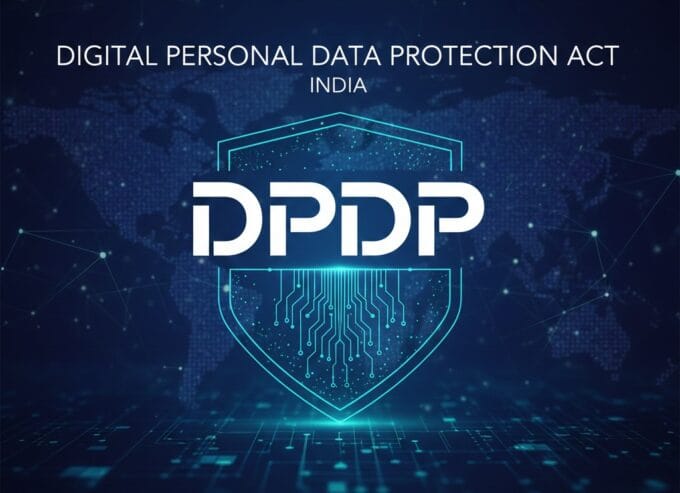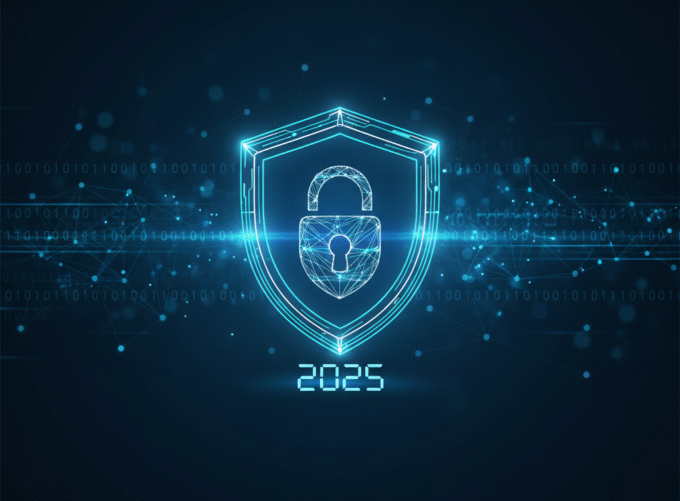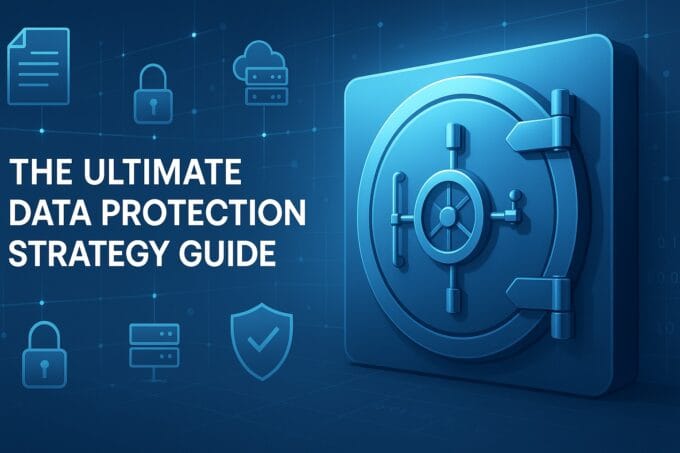Introduction: The Quiet Revolution That Could Break Your Business
Picture this scenario: You walk into the office one morning to discover that every encrypted file in your organization is suddenly readable by anyone with the right technology. Customer payment data, trade secrets, confidential communications, intellectual property—all of it exposed overnight. This isn’t the plot of a dystopian thriller; it’s the potential reality we face as quantum computing advances toward commercial viability.
Here’s the thing most executives don’t realize: the threat isn’t some distant science fiction concern. Currently, the median estimate among experts is that within 15 years, a quantum computer will be able to break RSA-2048 in 24 hours, according to the latest Quantum Threat Timeline Report. That RSA-2048 encryption? It’s probably protecting your most sensitive business data right now.
The urgency becomes clearer when you understand what cybersecurity experts call “Y2Q”—the year quantum computers become capable enough to crack current encryption. While we can’t predict the exact date, this year’s report, the sixth produced for GRI, suggests that the threat may be closer than previously thought. The global race to advance quantum computing isn’t just about scientific achievement—it’s creating a ticking clock for every organization that relies on digital security.
But here’s what makes this different from other technology transitions: you can’t wait until quantum computers arrive to start preparing. The migration to post quantum cryptography is complex, time-consuming, and requires careful strategic planning. Organizations that wait too long won’t just face technical challenges—they’ll face existential business risks.
This guide will walk you through everything you need to know about post quantum cryptography, translated from technical jargon into actionable business intelligence. By the end, you’ll understand the timeline, the business impact, and most importantly, the strategic steps your organization needs to take now to protect your future.
Table of Contents
Understanding the Quantum Timeline: When Should You Worry?
The reality is that quantum computing advancement follows an unpredictable trajectory, but recent developments suggest we’re closer than many executives realize. As more organisations discover its potential, the global market is expected to hit US$50 billion by the end of this decade. Major technology companies aren’t just investing—they’re already launching commercial quantum computing cloud services.
Let’s break down the timeline in business terms. Think of quantum computing development in three phases:
Phase 1: Current State (2024-2027)
We’re seeing impressive laboratory demonstrations, but quantum computers remain largely experimental for cryptographic threats. However, this is when smart organizations begin their post-quantum migration planning. FIPS 203, FIPS 204 and FIPS 205, which specify algorithms derived from CRYSTALS-Dilithium, CRYSTALS-KYBER and SPHINCS+, were published August 13, 2024. The standards are ready—the question is whether your organization is.
Phase 2: The Critical Decade (2027-2037)
This is when experts predict quantum computers could begin threatening current encryption methods. The National Institute for Standards and Technology (NIST) recommends migrating to new cryptographic systems by 2035 to mitigate forward-secrecy risks. Notice that timeline—organizations should complete their migration by 2035, which means starting the process now.
Phase 3: Post-Quantum Reality (2035+)
By this point, quantum computers capable of breaking current encryption may be widely available. Organizations that haven’t transitioned will face severe competitive and security disadvantages.
Here’s what many executives miss: the threat isn’t just about when quantum computers can break encryption—it’s about when attackers start collecting your encrypted data now to decrypt later. Security experts call this “harvest now, decrypt later” attacks. Your confidential data being encrypted today might be stored by adversaries, waiting for the quantum breakthrough that makes it readable.
The business implications are staggering. Consider that your current strategic plans, merger discussions, customer databases, and financial records could become retroactively compromised. This isn’t a technology problem—it’s a business continuity crisis waiting to happen.
Business Impact Assessment: What’s Really at Stake
When we talk about post quantum cryptography, we’re not discussing abstract mathematical concepts—we’re talking about the fundamental security infrastructure that makes modern business possible. Every digital transaction, secure communication, and data protection mechanism in your organization likely depends on encryption that quantum computers could eventually break.
Let’s examine what this means for different aspects of your business:
Financial Systems and Transactions
Your payment processing, banking connections, and financial reporting systems all rely on current encryption standards. A successful quantum attack could expose transaction histories, payment methods, and financial communications. For organizations in regulated industries, this doesn’t just represent a security breach—it’s a compliance catastrophe that could result in massive fines and regulatory sanctions.
Customer Data and Privacy
Customer trust is built on the promise that their personal information remains secure. Quantum computers could potentially expose customer databases, purchase histories, communications, and behavioral data collected over years or decades. In our interconnected economy, losing customer trust can destroy market value faster than any traditional business disruption.
Intellectual Property and Trade Secrets
Perhaps most critically for competitive advantage, your research data, strategic plans, proprietary algorithms, and trade secrets could become accessible to competitors or hostile actors. Unlike other security breaches that expose data at a single point in time, quantum threats could retroactively compromise years of archived communications and documents.
Supply Chain and Partner Communications
Modern businesses rely on secure communications with suppliers, partners, and vendors. Quantum computers could expose these relationships, contract negotiations, pricing discussions, and operational details. In industries where supply chain secrecy provides competitive advantage, this exposure could be devastating.
The challenge for executives is that these impacts won’t arrive gradually—they’ll happen suddenly when quantum computers cross the capability threshold. Transitioning to quantum-safe cryptography requires careful planning, time, and resources. Organizations that start planning now have the luxury of deliberate, strategic implementation. Those who wait may find themselves rushing through emergency migrations under pressure.
Industry-Specific Considerations
Different industries face varying levels of quantum risk. Financial services, healthcare, government contractors, and technology companies with valuable IP face the highest immediate risks. However, 62 percent of executives and board members from private sector enterprises consider quantum threats as a top challenge in 2024—and for the next 3 to 5 years, according to Deloitte’s quantum readiness survey.
Manufacturing companies with IoT devices, retail organizations with customer payment data, and professional services firms with confidential client information all need to assess their quantum risk exposure. The question isn’t whether your industry will be affected—it’s how quickly you’ll adapt when the change arrives. As we’ve seen with recent major cyber attacks on critical infrastructure, preparation and proactive security measures are essential for business continuity.
Current State of Post Quantum Solutions: What’s Available Now
The good news for business leaders is that post quantum cryptography isn’t theoretical—practical solutions exist today. The challenge is understanding which solutions fit your organization’s needs without getting lost in technical complexity.
NIST-Standardized Algorithms: The Gold Standard
The Secretary of Commerce has approved three Federal Information Processing Standards (FIPS) for post quantum cryptography: FIPS 203, 204 and 205. These aren’t experimental technologies—they’re production-ready standards that have undergone years of global scrutiny and testing.
Think of these standards like building codes for quantum-safe security. Just as you wouldn’t construct a building without following safety codes, implementing post quantum cryptography without following NIST standards creates unnecessary risk. The three primary standards cover different security functions:
- FIPS 203 (ML-KEM): Handles secure key exchange, like establishing secure connections between systems
- FIPS 204 (ML-DSA): Manages digital signatures, ensuring communications authenticity
- FIPS 205 (SLH-DSA): Provides backup digital signature capabilities for additional security
Vendor Solutions and Integration Options
Major technology vendors aren’t waiting for customer demand—they’re proactively building post-quantum capabilities into their products. In an announcement on 21 February, 2024, Apple unveiled what it called, “a groundbreaking post quantum cryptographic protocol for iMessage”. This represents the kind of forward-thinking approach that protects both the vendor and their customers.
Amazon, IBM, Google, and Microsoft have all integrated quantum-safe options into their cloud services. This means organizations can begin experimenting with post quantum cryptography without massive infrastructure investments. However, experimentation isn’t implementation—you’ll need a comprehensive strategy that covers all your critical systems.
Hybrid Approaches: Managing the Transition
Many organizations are adopting hybrid cryptographic systems that combine current encryption methods with post-quantum algorithms. This approach provides immediate quantum resistance while maintaining compatibility with existing systems. Think of it as wearing both a seatbelt and having airbags—multiple layers of protection during the transition period.
The hybrid approach makes particular sense for organizations with complex, interconnected systems that can’t be upgraded simultaneously. You can begin implementing post quantum cryptography in new projects while gradually upgrading existing systems.
Implementation Readiness Assessment
Before selecting specific solutions, organizations need to understand their current cryptographic footprint. This means identifying every system, application, and process that relies on encryption. Most executives are surprised by how extensive this list becomes—from email systems and VPNs to IoT devices and database connections.
Cost and Performance Considerations
Post quantum cryptography algorithms generally require more computational resources than current methods. However, the performance impact varies significantly depending on implementation and use case. For most business applications, the performance difference is negligible on modern hardware. The key is working with vendors who have optimized their implementations for real-world business requirements.
Early adopters often find that the performance concerns were overblown, while the competitive advantage of early quantum safe security implementation provides significant business value. Organizations that position themselves as quantum-safe can use this as a differentiator in customer negotiations and partnership discussions. This quantum cryptography business advantage often outweighs the initial implementation costs.
Strategic Planning Framework: How to Approach Organizational Preparation
Successful post-quantum migration isn’t a technology project—it’s a strategic business initiative that requires executive leadership, cross-functional coordination, and careful resource allocation. Here’s how forward-thinking organizations are approaching this challenge:
Phase 1: Risk Assessment and Discovery (Months 1-3)
Your first step is understanding what you’re protecting and from what threats. This goes beyond traditional IT asset inventory to include business impact analysis. Start by identifying your crown jewel data—the information that, if compromised, would cause the most significant business damage.
Create a comprehensive cryptographic inventory that maps every encryption touchpoint in your organization. This includes obvious systems like email and VPNs, but also embedded encryption in IoT devices, mobile applications, partner integrations, and legacy systems that may have been forgotten.
Most importantly, assess your regulatory and compliance requirements. Different industries and regions are developing post-quantum compliance timelines. Understanding these requirements early helps you prioritize implementation and avoid costly emergency compliance efforts.
Phase 2: Strategic Planning and Architecture Design (Months 4-9)
With your risk assessment complete, you can develop a migration strategy tailored to your organization’s needs. This isn’t about replacing everything at once—it’s about creating a prioritized roadmap that protects your most critical assets first while maintaining business continuity.
Consider your organization’s risk tolerance and competitive position. Early adopters can gain competitive advantages and customer confidence, while fast followers can benefit from proven implementations and lower costs. Neither approach is inherently better—the choice depends on your industry position and business strategy.
Design your target architecture with both current needs and future flexibility in mind. Organizations should continue to migrate their encryption systems to the standards we finalized in 2024, and we are announcing the selection of HQC because we want to have a backup standard that is based on a different math approach. Building flexibility into your architecture allows you to adapt as standards evolve.
Phase 3: Pilot Implementation and Testing (Months 6-12)
Start with low-risk, high-visibility implementations that demonstrate progress without jeopardizing critical operations. Internal communications systems, development environments, or new customer-facing applications make excellent pilot projects.
Use pilot implementations to build internal expertise and refine your deployment processes. Your IT team needs time to understand post-quantum technologies before implementing them across critical business systems. Similarly, your vendors need to understand your specific requirements and integration needs.
Document everything during pilot implementations. The lessons learned from your first post-quantum deployments will accelerate later phases and help you avoid costly mistakes during critical system migrations.
Phase 4: Scaled Deployment and Migration (Year 2-3)
With proven processes and internal expertise, you can begin systematic migration of production systems. Prioritize based on business risk, regulatory requirements, and technical complexity. High-value, low-complexity migrations should happen first.
Maintain parallel systems during migration to ensure business continuity. Unlike software upgrades that can be rolled back, cryptographic migrations often require careful coordination between multiple systems and partners.
Governance and Change Management
Post-quantum migration affects every department that uses digital systems—essentially your entire organization. Establish clear governance structures with executive sponsorship and cross-functional representation. This isn’t an IT project that other departments can ignore.
Communication strategy is critical. Employees, customers, and partners need to understand why you’re making these changes and how it affects them. Frame the migration in terms of competitive advantage and customer protection rather than technical compliance.
Vendor Evaluation Guide: Key Questions Executives Should Ask
Selecting post quantum cryptography solutions requires asking the right questions to cut through marketing hype and technical complexity. Here’s your executive-level vendor evaluation framework:
Standards Compliance and Future-Proofing
“Which NIST post-quantum standards does your solution implement, and how do you plan to support future standards?” This isn’t just about current compliance—it’s about ensuring your investment remains valid as standards evolve. Vendors should demonstrate clear roadmaps for supporting emerging standards and algorithm updates.
“How does your solution handle the transition from current encryption to post-quantum methods?” Look for vendors that offer hybrid approaches and gradual migration capabilities rather than requiring immediate, complete system replacement.
Business Impact and Integration
“What is the performance impact on our current systems, and how do you minimize disruption during implementation?” Get specific metrics for your use cases, not generic benchmarks. A 10% performance decrease might be acceptable for batch processing but unacceptable for real-time customer transactions.
“How does your solution integrate with our existing security infrastructure and vendor ecosystem?” Post quantum cryptography doesn’t exist in isolation—it needs to work with your current firewalls, identity management, monitoring tools, and business applications.
Implementation and Support Capabilities
“What implementation services do you provide, and what expertise do you require from our team?” Understanding the human resource requirements helps you budget appropriately and avoid project delays due to skills gaps.
“How do you handle emergency updates if vulnerabilities are discovered in post-quantum algorithms?” The quantum-safe cryptography field is still evolving, and vendors need clear processes for rapid security updates.
Long-term Partnership and Viability
“What is your long-term commitment to post-quantum cryptography, and how do you stay current with evolving threats?” You’re not just buying software—you’re entering a long-term partnership for quantum-safe security.
“Can you provide references from organizations similar to ours who have completed post-quantum implementations?” Real-world case studies are more valuable than laboratory benchmarks for understanding business impact.
Cost and ROI Considerations
“What is the total cost of ownership including licensing, implementation, training, and ongoing support?” Many post-quantum solutions have hidden costs in terms of increased computational requirements, additional hardware, or specialized training needs.
“How do you demonstrate ROI beyond risk mitigation?” Leading vendors can articulate competitive advantages, customer confidence benefits, and operational improvements beyond basic security compliance.
Risk Management and Compliance
“How does your solution address our specific regulatory requirements and industry compliance needs?” Generic compliance statements aren’t sufficient—you need vendors who understand your industry’s specific requirements.
“What happens to our data and systems if your company is acquired or changes strategic direction?” Post quantum cryptography represents a long-term infrastructure investment, and vendor stability is crucial for protecting that investment.
Technical Scalability and Flexibility
“How does your solution scale with our business growth and changing security requirements?” Your post-quantum solution needs to grow with your organization and adapt to evolving threat landscapes.
“What level of customization and configuration flexibility do you provide?” Different organizations have different security requirements, and one-size-fits-all solutions rarely provide optimal protection.
Implementation Roadmap: Practical Steps and Timeline for Getting Started
Creating a successful post-quantum implementation requires balancing urgency with careful planning. Here’s your practical roadmap for beginning this critical business transformation:
Immediate Actions (Next 30 Days)
Start by establishing executive sponsorship and forming a cross-functional quantum-safe task force. This team should include representation from IT, security, legal, compliance, and key business units. Without clear leadership commitment, post-quantum initiatives often stall in planning phases.
Conduct a high-level cryptographic asset inventory focusing on business-critical systems. You don’t need complete technical documentation yet—start by identifying systems that would cause the most business damage if compromised. This business-first approach helps prioritize technical work.
Begin vendor conversations and industry research. Understanding available solutions and implementation approaches takes time, and early conversations help vendors understand your specific requirements. Many vendors offer free assessments or proof-of-concept implementations for qualified prospects.
Short-term Objectives (Next 3-6 Months)
Complete comprehensive risk assessment and cryptographic discovery. This detailed analysis forms the foundation for all implementation decisions. Include third-party systems, partner integrations, and cloud services in your assessment—post-quantum security is only as strong as your weakest cryptographic link.
Develop your migration strategy and budget proposal. Executive teams need clear understanding of costs, timelines, and business benefits to approve major cryptographic infrastructure changes. Frame the proposal in terms of business risk mitigation and competitive advantage rather than technical compliance.
Select initial pilot projects and begin vendor evaluation processes. Choose pilot projects that provide valuable learning opportunities without risking critical business operations. Internal communications, development environments, or new product initiatives often make excellent starting points.
Medium-term Implementation (6-18 Months)
Execute pilot implementations and build internal expertise. Your IT and security teams need hands-on experience with post-quantum technologies before deploying them across production systems. Document lessons learned and refine deployment processes during pilot phases.
Begin production migration for high-priority, low-risk systems. Early production implementations should focus on systems that provide significant business value with minimal integration complexity. Success with these initial deployments builds organizational confidence for more complex migrations.
Establish ongoing monitoring and maintenance processes for post-quantum systems. These solutions require different monitoring approaches than traditional encryption, and your operations teams need time to develop appropriate expertise and procedures.
Long-term Migration (18-36 Months)
Execute systematic migration of remaining production systems based on business priority and technical complexity. By this point, your organization should have proven processes, trained personnel, and vendor relationships that enable efficient large-scale deployment.
Integrate post-quantum considerations into all new system development and vendor selection processes. Future systems should be quantum-safe by design rather than requiring expensive retrofitting.
Ongoing Management and Evolution
Post quantum cryptography isn’t a one-time implementation—it’s an ongoing business capability that requires continuous attention. The National Institute of Standards and Technology (NIST) has released an initial public draft report on transitioning to post quantum cryptography (PQC) standards, and these standards will continue evolving based on new research and threat developments.
Establish regular review cycles for quantum threat intelligence and standards updates. The quantum computing field advances rapidly, and your security posture needs to evolve accordingly. Subscribe to relevant industry publications and maintain relationships with quantum-safe technology vendors.
Develop quantum-safe incident response procedures. While we hope quantum attacks never occur, your organization needs clear procedures for responding to potential quantum-enabled security breaches. This includes forensic capabilities, communication protocols, and recovery procedures.
Success Metrics and Milestones
Measure progress using business-relevant metrics rather than purely technical indicators. Track percentage of critical business data protected by quantum-safe encryption, reduction in quantum-related security risks, and compliance with emerging regulatory requirements.
Monitor vendor performance and solution effectiveness over time. Post quantum cryptography performance characteristics may differ from traditional encryption, and you need ongoing measurement to ensure solutions continue meeting business requirements.
Conclusion: Taking Action in an Uncertain Timeline
The quantum threat represents a unique challenge for business leaders: we know the threat is real and potentially devastating, but we can’t predict exactly when it will arrive. This uncertainty doesn’t justify inaction—it demands strategic preparation.
Here’s what you need to remember: post quantum cryptography isn’t just about protecting data—it’s about protecting business continuity, competitive advantage, and customer trust in an increasingly digital economy. Organizations that begin their quantum-safe journey now will have significant advantages over those who wait for certainty.
The key takeaways for executive action:
Start Now, But Start Smart
The median estimate among experts is that within 15 years, a quantum computer will be able to break RSA-2048 in 24 hours. Fifteen years sounds like plenty of time, but complex cryptographic migrations require years of careful planning and implementation. Early action provides flexibility and competitive advantage.
Focus on Business Impact, Not Technical Complexity
Your role isn’t to understand the mathematical details of post-quantum algorithms—it’s to ensure your organization’s critical business functions remain secure and compliant. Frame post-quantum migration as a business continuity initiative with technical components, not a technical project with business implications.
Build Partnerships and Expertise
No organization can navigate the post-quantum transition alone. Establish relationships with quantum-safe technology vendors, industry organizations, and security consultants who specialize in this area. Your internal team needs support from external experts who live and breathe quantum-safe cryptography.
The quantum revolution is coming whether we’re ready or not. The question isn’t whether your organization will eventually implement post quantum cryptography—it’s whether you’ll be prepared when the transition becomes urgent, or scrambling to catch up when it’s too late.
Your next step is simple: schedule a quantum-safe assessment meeting with your security team within the next 30 days. Begin the conversation, understand your current exposure, and start building the strategic plan that will protect your organization’s future.
The quantum age is approaching. Make sure your business is ready.
Frequently Asked Questions
Q: How much will post-quantum migration cost our organization?
Costs vary significantly based on your current infrastructure complexity and migration timeline. Most organizations find that early, planned migration costs 20-30% less than emergency implementations. The largest costs typically involve staff training, vendor services, and potential hardware upgrades rather than software licensing.
Q: Can we wait until quantum computers actually threaten current encryption?
Waiting is extremely risky for two reasons: migration takes years to complete safely, and attackers may already be collecting encrypted data to decrypt later. Organizations that wait until quantum threats are immediate will face rushed implementations, higher costs, and potential security gaps during transition.
Q: Will post-quantum cryptography slow down our systems significantly?
Modern implementations have minimal performance impact on most business applications. While post-quantum algorithms require more computational resources than current methods, the difference is typically negligible on contemporary hardware. Performance impact should be tested during pilot implementations for your specific use cases.
Q: How do we know which post-quantum standards to implement?
Focus on NIST-standardized algorithms (FIPS 203, 204, and 205) for production implementations. These have undergone extensive global review and provide the best balance of security, performance, and long-term viability. Avoid proprietary or non-standardized solutions unless you have specific technical requirements that standards don’t address.
Q: What happens if vulnerabilities are discovered in post-quantum algorithms?
Like all cryptographic systems, post-quantum algorithms may have vulnerabilities discovered over time. This is why hybrid approaches and vendor update capabilities are important. Choose solutions and vendors that can rapidly deploy algorithm updates and maintain multiple cryptographic approaches for resilience.
Q: How does post quantum cryptography affect our compliance requirements?
Regulatory requirements for post quantum cryptography are still developing, but early compliance often provides competitive advantages. Many industries are beginning to include quantum-safe requirements in their security frameworks. Starting migration now helps ensure you’ll meet future compliance requirements without emergency implementations.
Q: Should we implement post quantum cryptography for all systems simultaneously?
No. Successful organizations use phased approaches that prioritize high-value, low-complexity systems first. This builds internal expertise and proven processes before tackling complex, mission-critical systems. Simultaneous implementation across all systems is unnecessarily risky and expensive.

















Leave a comment